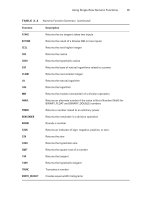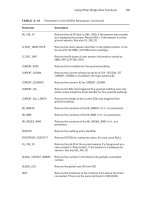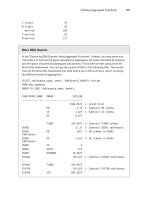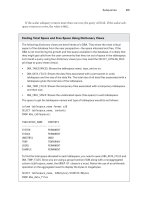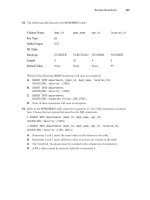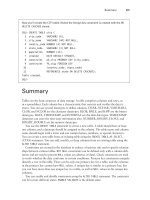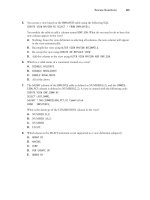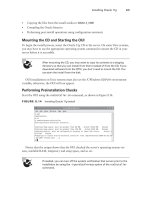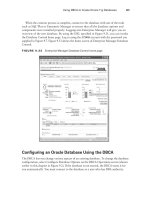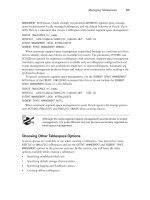Tài liệu OCA: Oracle Database 11g Administrator Certified Associate- P21 pdf
Bạn đang xem bản rút gọn của tài liệu. Xem và tải ngay bản đầy đủ của tài liệu tại đây (1023.32 KB, 50 trang )
Exam Essentials
831
Exam Essentials
Understand the Automatic Workload Repository. Describe the components of the AWR
and how they are used to collect and store database performance statistics.
Describe the role of Automatic Database Diagnostic Monitor. Know how ADDM uses the
AWR statistics to formulate tuning recommendations using historical and baseline metrics.
Explain how each advisor is used to improve performance. Describe how you can use
each of the EM Database Control advisors shown on the Advisor Central screen to improve
database performance and manageability.
Describe how alerts are used to monitor performance. Show how you can configure the
EM Database Control alert system to alert you via the console or via email whenever a
monitored event occurs in the database.
Remember the location of alert log file. Starting in Oracle 11g, the alert log file location is
determined by the
DIAGNOSTIC_DEST
parameter. Learn the location of the text alert log file
and XML alert log file.
Identify and fix invalid or unusable objects. Understand the techniques you can use to
identify invalid procedures, functions, triggers, and views and how to validate them. Know
how to find unusable indexes and how to fix them.
Understand Automatic Memory Management. Know the parameters that control the
memory management and how the pools are allocated.
Understand sources of tuning information. Know in which dynamic performance views,
data dictionary views, and log files tuning information can be found outside the EM Data-
base Control monitoring system.
95127c14.indd 831 2/17/09 2:54:23 PM
Please purchase PDF Split-Merge on www.verypdf.com to remove this watermark.
832
Chapter 14
N
Maintaining the Database and Managing Performance
Review Questions
1. Which of the following components of the Oracle architecture stores the statistics gathered
by the MMON process?
A. ADDM
B. AW R
C. ASMM
D. ADR
2. Which of the following options for the pfile/spfile’s STATISTICS_LEVEL parameter turns off
AWR statistics gathering and ADDM advisory services?
A. OFF
B. TYPICAL
C. ALL
D. BASIC
3. Which parameter is used to enable Automatic Memory Management?
A. AMM_TARGET
B. MEMORY_TARGET
C. SGA_TARGET
D. All of the above
4. Which statement about an index with the status UNUSABLE in DBA_INDEXES is true?
A. The index will be automatically fixed the next time it is used.
B. The Oracle optimizer throws an error when it tries to use the index.
C. The index must be recompiled using the ALTER INDEX…RECOMPILE statement.
D. The index must be reorganized using the ALTER INDEX…REBUILD statement before it
can be used again.
5. Suppose you have used EM Database Control to drill down into ADDM findings and have
found that a single SQL statement is causing the majority of I/O on your system. Which of
the following advisors is best suited to troubleshoot this SQL statement?
A. SQL Tuning Advisor
B. SQL Access Advisor
C. Both A and B
D. Neither A nor B
95127c14.indd 832 2/17/09 2:54:23 PM
Please purchase PDF Split-Merge on www.verypdf.com to remove this watermark.
Review Questions
833
6. You found out that few procedures in the APPS schema have an INVALID status in the DBA_
OBJECTS view. What are your options to fix the issue? (Choose the best two answers.)
A. Do nothing. When the procedure is accessed the next time, Oracle will try to recompile.
B. Drop the procedure so that users get a valid error.
C. Recompile the procedure using ALTER PROCEDURE…COMPILE.
D. Contact the developer or vendor to get the source code and re-create the procedure.
7. Which procedure is used to tell Oracle that the statistics gathered should not be published?
A. DBMS_STATS.PUBLISH_STATS
B. DBMS_STATS.SET_TABLE_PREFS
C. DBMS_STATS.PENDING_STATS
D. DBMS_STATS.GATHER_TABLE_STATS
8. Which data dictionary view contains information explaining why ADDM made its recom-
mendations?
A. DBA_ADVISOR_FINDINGS
B. DBA_ADVISOR_OBJECTS
C. DBA_ADVISOR_RECOMMENDATIONS
D. DBA_ADVISOR_RATIONALE
9. Which of the following advisors determines whether the space allocated to the shared pool,
large pool, or buffer cache is adequate?
A. SQL Tuning Advisor
B. SGA Tuning Advisor
C. Memory Advisor
D. Pool Advisor
10. Which of the following advisors determines whether the estimated instance-recovery dura-
tion is within the expected service-level agreements?
A. Undo Management Advisor
B. SQL Access Advisor
C. SQL Tuning Advisor
D. MTTR Advisor
11. If no email address is specified, where will alert information be displayed?
A. In the DBA_ALERTS data dictionary view.
B. In the V$ALERTS dynamic performance view.
C. In the EM Database Control main screen.
D. No alert information is sent or displayed.
95127c14.indd 833 2/17/09 2:54:24 PM
Please purchase PDF Split-Merge on www.verypdf.com to remove this watermark.
834
Chapter 14
N
Maintaining the Database and Managing Performance
12. When you configure an alert, which of the following types of alert thresholds can you use
to monitor a tablespace for diminishing free space?
A. Warning threshold
B. Critical threshold
C. Both A and B
D. Neither A nor B
13. Multiple baseline metrics can be gathered and stored in the AWR. Why might you want
more than one metrics baseline?
A. You might want a separate baseline metric for each user.
B. You might want a separate baseline metric for daytime usage vs. off-hours usage.
C. You might want a separate baseline metric for each schema.
D. You would never want more than one baseline metric, even though it is possible to
gather and store them.
14. Using EM Database Control, you discover that two application PL/SQL functions and
a view are currently invalid. Which of the following might you use to fix these objects?
(Choose two.)
A. Shut down and restart the database.
B. Use EM Database Control to recompile the object.
C. Export the invalid objects, drop them, and then import them.
D. Use the ALTER FUNCTION…COMPILE and ALTER VIEW…COMPILE commands.
15. Which statement about MEMORY_TARGET parameter is not true?
A. It is a dynamic initialization parameter.
B. It represents the total maximum memory that can be allocated to the instance memory
(PGA and SGA combined).
C. Its default value is zero.
D. You will not get an error when SGA_TARGET and PGA_AGGREGATE_TARGET parameters
are set to nonzero values.
16. Which of the following is a performance metric that could be defined as “the amount of
work that a system can perform in a given amount of time”?
A. Response time
B. Uptime
C. Throughput
D. Runtime
95127c14.indd 834 2/17/09 2:54:24 PM
Please purchase PDF Split-Merge on www.verypdf.com to remove this watermark.
Review Questions
835
17. Which of the following is typically not one of the three primary sources of performance
metric information on the EM Database Control Performance tab?
A. Host
B. Session
C. Instance
D. Network
18. By default, how long will database statistics be retained in the AWR?
A. 7 days
B. 30 days
C. 7 hours
D. Indefinitely
19. Your users have called to complain that system performance has suddenly decreased mark-
edly. Where would be the most likely place to look for the cause of the problem in EM
Database Control?
A. Main screen
B. Performance tab
C. Administration tab
D. Maintenance tab
20. Using EM Database Control, you’ve identified that the following SQL statement is the
source of a high amount of disk I/O:
SELECT NAME, LOCATION, CREDIT_LIMIT FROM CUSTOMERS
What might you do first to try to improve performance?
A. Run the SQL Tuning Advisor.
B. Run the SQL Access Advisor.
C. Check the EM Database Control main screen for alerts.
D. Click the Alert Log Content link in the EM Database Control main screen.
95127c14.indd 835 2/17/09 2:54:24 PM
Please purchase PDF Split-Merge on www.verypdf.com to remove this watermark.
836
Chapter 14
N
Maintaining the Database and Managing Performance
Answers to Review Questions
1. B. The MMON process gathers statistics from the SGA and stores them in the AWR. The
ADDM process then uses these statistics to compare the current state of the database with
baseline and historical performance metrics before summarizing the results on the EM
Database Control screens.
2. D. Setting STATISTICS_LEVEL = BASIC disables the collection and analysis of AWR statis-
tics. TYPICAL is the default setting, and ALL gathers information for the execution plan and
operating-system timing. OFF is not a valid value for this parameter.
3. B. Automatic Memory Management is enabled by setting a nonzero value for the MEMORY_
TARGET parameter. The default value for this parameter is zero. SGA_TARGET enables the
ASSM (Automatic Shared Memory Management) feature.
4. D. Unusable indexes must be manually rebuilt by the DBA, or the user owning the index
can rebuild or drop/recreate as well, before the index can be used. The Oracle optimizer
ignores the unusable index.
5. C. You can use the SQL Tuning Advisor and SQL Access Advisor together to determine
whether I/O can be minimized and overall DB Time reduced to the targeted SQL statement.
6. A, C. Invalid PL/SQL objects will be automatically recompiled the next time they are
accessed. The DBA can manually recompile the procedure. Manual recompilation is the
recommended approach.
7. B. The DBMS_STATS.SET_TABLE_PREFS procedure is used to set the PUBLISH preference to
FALSE. To be able to use the pending statistics, the OPTIMIZER_USE_PENDING_STATISTICS
parameter must be set to TRUE in the session.
8. D. DBA_ADVISOR_RATIONALE provides the rationale for each ADDM recommendation. The
ADDM findings are stored in DBA_ADVISOR_FINDINGS. The objects related to the findings
are shown in DBA_ADVISOR_OBJECTS. The actual ADDM recommendations are found in
DBA_ADVISOR_RECOMMENDATIONS.
9. C. The Memory Advisor can help determine whether the overall size of the SGA is appro-
priate and whether memory is properly allocated to the SGA components.
10. D. The Mean Time To Recover (MTTR) Advisor provides recommendations that you can use
to configure the database so that the instance-recovery time fits within the service levels that
you specified.
11. C. By default, alerts are displayed in the Alerts section of the EM Database Control main
screen, even when email notifications are not configured.
12. C. You can specify both warning and critical thresholds for monitoring the available free
space in a tablespace. In this situation, the warning threshold is generally a lower number
than the critical threshold.
95127c14.indd 836 2/17/09 2:54:24 PM
Please purchase PDF Split-Merge on www.verypdf.com to remove this watermark.
Answers to Review Questions
837
13. B. Because many transactional systems run batch processing during off-hours, having a
relevant baseline for each type of usage pattern yields better results in terms of alerts and
ADDM recommendations.
14. B, D. After fixing the issue that originally caused the invalid status, you can use both EM
Database Control and SQL to compile an invalid object. Starting and stopping the database
will not fix invalid objects. Export/import is also not an appropriate technique for recom-
piling invalid objects.
15. B. MEMORY_TARGET represents the total size allocated for SGA and PGA components. The
maximum that can be allocated for these structures is determined by the MEMORY_MAX_
TARGET parameter. You still can set the SGA_TARGET and PGA_AGGREGATE_TARGET param-
eters; Oracle will use these as the minimums.
16. C. Throughput is an important performance metric because it is an overall measure of
performance that can be compared against similar measures taken before and after tuning
changes are implemented.
17. D. Network information may be contained in the Session Information section of the EM
Database Control Performance screen, but only if network issues contributed to session
wait times.
18. A. By default, database statistics are retained in the AWR for seven days. You can change
the default duration using the EM Database Control Automatic Workload Repository link
on the Performance tab or using the DBMS_WORKLOAD_REPOSITORY PL/SQL package.
19. B. The Performance tab of EM Database Control provides a quick overview of how the
host system, user sessions, and throughput are impacted by the system slowdown. You can
also drill down into any of these three areas to take a look at details about this slowdown.
20. A. Running the SQL Tuning Advisor provides the most information about how the perfor-
mance of this SQL statement might be improved. The SQL Access Advisor is run only after
the output from the SQL Tuning Advisor indicates that it will be useful. EM Database Control
does not store detailed information about I/O activity in either its alerts or the alert log.
95127c14.indd 837 2/17/09 2:54:24 PM
Please purchase PDF Split-Merge on www.verypdf.com to remove this watermark.
95127c14.indd 838 2/17/09 2:54:24 PM
Please purchase PDF Split-Merge on www.verypdf.com to remove this watermark.
Chapter
15
Implementing
Database Backups
ORACLE DATABASE 11g:
ADMINISTRATION I EXAM OBJECTIVES
COVERED IN THIS CHAPTER:
Backup and Recovery Concepts
Identify the importance of checkpoints, redo log files, and
archived log files
Overview of flash recovery area
Configure ARCHIVELOG mode
Performing Database Backups
Create consistent database backups
Back up your database without shutting it down
Create incremental backups
Automate database backups
Manage backups, view backup reports and monitor the flash
recovery area
95127c15.indd 839 2/17/09 3:01:51 PM
Please purchase PDF Split-Merge on www.verypdf.com to remove this watermark.
Oracle’s administration tool, Enterprise Manager Database
Control, makes configuring and performing backups easier.
Most, if not all, of the functionality available with the
command-line interface is available in a graphical user interface to save time and make
backup operations less error-prone.
Oracle Database 11g makes it easy for you to configure your database to be highly
available and reliable. In other words, you want to configure your database to minimize
the amount of downtime while at the same time being able to recover quickly and without
losing any committed transactions when the database becomes unavailable for reasons that
may be beyond your control.
In this chapter, I will first describe the components you will use to minimize or eliminate
data loss in your database while at the same time keeping availability high. Specifically, I
will cover the following:
Checkpoints
Redo log files
Archived redo log files
The flash recovery area
Next, you will learn how to configure your database for recovery. This will include a
discussion of
ARCHIVELOG
mode and other required initialization parameters. Once your
environment is configured, you will need to know how to actually back it up, using both
operating-system commands and the RMAN utility. You will also learn how to automate
and manage your backups as well as how to monitor one of the key components in your
backup strategy: the flash recovery area. In Chapter 16, “Recovering the Database,” you
will then learn how to use the files created and maintained during your backups to quickly
recover the database in the event of a database failure.
Understanding and Configuring
Recovery Components
As a database administrator, your primary goal is to keep the database open and available
for users, usually 24 hours a day, 7 days a week. Your partnership with the server’s system
administrator includes the following tasks:
Proactively solving common causes of failures
Increasing the mean time between failure (MTBF)
95127c15.indd 840 2/17/09 3:01:51 PM
Please purchase PDF Split-Merge on www.verypdf.com to remove this watermark.
Understanding and Configuring Recovery Components
841
Ensuring a high level of hardware redundancy
Increasing availability by using Oracle options such as Real Application Clusters
(RAC) and Oracle Streams (an advanced replication technology)
Decreasing the mean time to recover (MTTR) by setting the appropriate Oracle ini-
tialization parameters and ensuring that backups are readily available in a recovery
scenario
Minimizing or eliminating loss of committed transactions by using archived redo logs,
standby databases, and Oracle Data Guard
A number of structures and events in the database directly support backup and recovery
operations. The control files maintain the list of database files in the database, along with
a record of the most recent database backups (if you are using RMAN for your backups).
The checkpoint (CKPT) background process works in concert with the database writer
(DBWn)
process to manage the amount of time required for instance recovery; during instance
recovery,
the redo log files are used to synchronize the data files. For more serious types of
failures, such as media failures, archived redo log files are applied to a restored backup copy
of a data file to synchronize the data files and ensure that no committed transactions are lost.
Finally, the flash recovery area, introduced in Oracle 10g, is a common area for all recovery-
related files that makes your job much easier when backing up or recovering your database.
To maximize your database’s availability, it almost goes without saying that you want to
perform regularly scheduled backups. Most media failures require some kind of restoration
of a data file from a disk or tape backup before you can initiate media recovery.
In addition to regularly scheduled backups (see the section “Performing Backups” later
in this chapter), you can configure a number of other features to maximize your database’s
availability and minimize recovery time, such as multiplexing control files, multiplexing redo
log files, configuring the database in
ARCHIVELOG
mode, and using a flash recovery area.
Understanding Control Files
The control file is one of the smallest, yet also one of the most critical, files in the database.
Recovering from the loss of one copy of a control file is relatively straightforward; recov-
ering from the loss of your only control file or all control files is more of a challenge and
requires more-advanced recovery techniques.
In the following section, you will get an overview of the control file architecture. You
will then learn how maximize the recoverability of the control file in the section “Multi-
plexing Control Files.”
Control File Architecture
The control file is a relatively small (in the megabyte range) binary file that contains informa-
tion about the structure of the database. You can think of the control file as a metadata reposi-
tory for the physical database. It has the structure of the database, meaning the data files and
redo log files constitute a database. The control file is created when the database is created and
is updated with the physical changes, for example, whenever you add or rename a file.
The control file is updated continuously and should be available at all times. Don’t edit
the contents of the control file; only Oracle processes should update its contents. When you
95127c15.indd 841 2/17/09 3:01:51 PM
Please purchase PDF Split-Merge on www.verypdf.com to remove this watermark.
842
Chapter 15
Implementing Database Backups
start up the database, Oracle uses the control file to identify and to open the data files and
redo log files. Control files play a major role when recovering a database.
The contents of the control file include the following:
The database name to which the control file belongs. A control file can belong to only
one database.
The database-creation timestamp.
The name, location, and online/offline status information of the data files.
The name and location of the redo log files.
Redo log archive information.
Tablespace names.
The current log sequence number, which is a unique identifier that is incremented and
recorded when an online redo log file is switched.
The most recent checkpoint information.
The beginning and ending of undo segments.
Recovery Manager’s backup information. Recovery Manager (RMAN) is the Oracle
utility you use to back up and recover databases.
The control file size is determined by the
MAX
clauses you provide when you create the
database:
MAXLOGFILES
MAXLOGMEMBERS
MAXLOGHISTORY
MAXDATAFILES
MAXINSTANCES
Oracle preallocates space for these maximums in the control file. Therefore, when you
add or rename a file in the database, the control file size does not change.
When you add a new file to the database or relocate a file, an Oracle server process imme-
diately updates the information in the control file. Back up the control file after any struc-
tural changes. The log writer (LGWR) process updates the control file with the current log
sequence number. The CKPT process updates the control file with the recent checkpoint infor-
mation. When the database is in
ARCHIVELOG
mode, the archiver (ARCn) process updates the
control file with information such as the archive log filename and log sequence number.
The control file contains two types of record sections: reusable and not reusable.
RMAN information is kept in the reusable section. Items such as the names of the backup
data files are kept in this section, and once this section fills up, the entries are reused
in a circular fashion after the number of days specified by the initialization parameter
CONTROL_FILE_RECORD_KEEP_TIME
is reached. Therefore, the control file can continue
to grow because of new RMAN backup information recorded in the control file before
CONTROL_FILE_RECORD_KEEP_TIME
.
95127c15.indd 842 2/17/09 3:01:52 PM
Please purchase PDF Split-Merge on www.verypdf.com to remove this watermark.
Understanding and Configuring Recovery Components
843
You can query the control file names and their status by using EM Database Control.
On the Server tab, click the Control Files link under Storage. You will see the Control Files
screen, as shown in Figure 15.1.
FIGURE 15.1 Control Files screen of EM
The Record Section tab on this screen shows the record information from the control file,
as shown in Figure 15.2. It shows the size used in the control file for each section, the total
number of records that can be saved with the current size of the control file, and the number
or records used.
FIGURE 15.2 Control Files screen’s Record Section tab
95127c15.indd 843 2/17/09 3:01:52 PM
Please purchase PDF Split-Merge on www.verypdf.com to remove this watermark.
844
Chapter 15
Implementing Database Backups
Multiplexing Control Files
Because the control file is critical for database operation, at a minimum you must have two
copies of the control file; Oracle recommends a minimum of three copies. You duplicate the
control file on different disks either by using the multiplexing feature of Oracle or by using
the mirroring feature of your operating system. If you have multiple disk controllers on your
server, at least one copy of the control file should reside on a disk managed by a different
disk controller.
If you use the Database Configuration Assistant (DBCA) to create your database, three
copies of the control files are multiplexed by default.
The next two sections discuss the two ways that you can implement the multiplexing
feature: using an
init.ora
and using the server-side spfile.
Multiplexing Control Files Using init.ora
Multiplexing means keeping a copy of the same control file on different disk drives and
ideally on different controllers too. To multiplex a control file, copy the control file to mul-
tiple locations and change the
CONTROL_FILES
parameter in the text-based initialization file
init.ora
to include all control filenames. The following syntax shows three multiplexed
control files:
CONTROL_FILES = (‘/ora01/oradata/MYDB/ctrlMYDB01.ctl’,
‘/ora02/oradata/MYDB/ctrlMYDB02.ctl’,
‘/ora03/oradata/MYDB/ctrlMYDB03.ctl’)
By storing the control file on multiple disks, you avoid the risk of a single point of fail-
ure. When multiplexing control files, updates to the control file can take a little longer,
but that is insignificant when compared with the benefits. If you lose one control file, you
can restart the database after copying one of the other control files or after changing the
CONTROL_FILES
parameter in the initialization file.
When multiplexing control files, Oracle updates all the control files at the same time but
uses only the first control file listed in the
CONTROL_FILES
parameter for reading.
When creating a database, you can list the control file names in the
CONTROL_FILES
param-
eter, and Oracle creates as many control files as are listed. You can have a maximum of eight
multiplexed control file copies.
If you need to add more control file copies, follow these steps:
1.
Shut down the database.
SQL> SHUTDOWN NORMAL
2.
Copy the control file to more locations by using an operating-system command:
$ cp /u02/oradata/ord/control01.ctl /u05/oradata/ord/control04.ctl
3.
Change the initialization-parameter file to include the new control file name(s) in the
parameter
CONTROL_FILES
by changing this:
CONTROL_FILES=(‘/u02/oradata/ord/control01.ctl’,
‘/u03/oradata/ord/control02.ctl’,
‘/u04/oradata/ord/control03.ctl’)
95127c15.indd 844 2/17/09 3:01:52 PM
Please purchase PDF Split-Merge on www.verypdf.com to remove this watermark.
Understanding and Configuring Recovery Components
845
to this:
CONTROL_FILES=(‘/u02/oradata/ord/control01.ctl’,
‘/u03/oradata/ord/control02.ctl’,
‘/u04/oradata/ord/control03.ctl’,
‘/u05/oradata/ord/control04.ctl’)
4.
Start the instance:
SQL> STARTUP
This procedure is somewhat similar to the procedure for recovering from the loss of a
control file.
You can find examples of control file recovery in Chapter 16.
After creating the database, you can change the location of the control files, rename the
control files, or drop certain control files. You must have at least one control file for each
database. To add, rename, or delete control files, you need to follow the preceding steps.
Basically, you shut down the database, use the operating-system copy command (copying,
renaming, or deleting the control files accordingly), modify the
init.ora
parameter file,
and start up the database.
Multiplexing Control Files Using an Spfile
Multiplexing using a binary spfile is similar to multiplexing using
init.ora
. The major
difference is in how the
CONTROL_FILES
parameter is changed. Follow these steps:
1.
Alter the spfile while the database is still open:
SQL> ALTER SYSTEM SET CONTROL_FILES =
‘/ora01/oradata/MYDB/ctrlMYDB01.ctl‘,
‘/ora02/oradata/MYDB/ctrlMYDB02.ctl‘,
‘/ora03/oradata/MYDB/ctrlMYDB03.ctl‘,
‘/ora04/oradata/MYDB/ctrlMYDB04.ctl‘ SCOPE=SPFILE;
This parameter change takes effect only after the next instance restart by using the
SCOPE=SPFILE
qualifier. The contents of the binary spfile are changed immediately, but
the old specification of
CONTROL_FILES
is used until the instance is restarted.
2.
Shut down the database:
SQL> SHUTDOWN NORMAL
3.
Copy an existing control file to the new location:
$ cp /ora01/oradata/MYDB/ctrlMYDB01.ctl /ora04/oradata/MYDB/ctrlMYDB04.ctl
4.
Start the instance:
SQL> STARTUP
95127c15.indd 845 2/17/09 3:01:52 PM
Please purchase PDF Split-Merge on www.verypdf.com to remove this watermark.
846
Chapter 15
Implementing Database Backups
Understanding Checkpoints
The CKPT process controls the amount of time required for instance recovery. During a
checkpoint, CKPT updates the control file and the header of the data files to reflect the last
successful transaction by recording the last system change number (SCN). The SCN, which
is a number sequentially assigned to each transaction in the database, is also recorded in
the control file against the data file name that is taken offline or made read-only.
A checkpoint occurs automatically every time a redo log file switch occurs, either when
the current redo log file fills up or when you manually switch redo log files. The DBWn pro-
cesses in conjunction with CKPT routinely write new and changed buffers to advance the
checkpoint from where instance recovery can begin, thus reducing the MTTR.
You can find more information on tuning the MTTR and how often check-
pointing occurs in Chapter 16.
Understanding Redo Log Files
A redo log file records all changes to the database, in most cases before the changes are
written to the data files.
To recover from an instance or a media failure, redo log information is required to
roll data files forward to the last committed transaction. Ensuring that you have at least
two members for each redo log file group dramatically reduces the likelihood of data loss
because the database continues to operate if one member of a redo log file is lost.
In the following sections, I will give you an architectural overview of redo log files, as
well as show you how to add redo log groups, add or remove redo log group members, and
clear a redo log group in case one of the redo log group’s members becomes corrupted.
Redo Log File Architecture
Online redo log files are filled with redo records. A redo record, also called a redo entry,
consists of a group of change vectors, each of which describes a change made to a single
block in the database. Redo entries record data that you can use to reconstruct all changes
made to the database, including the undo segments. When you recover the database by
using redo log files, Oracle reads the change vectors in the redo records and applies the
changes to the relevant blocks.
The LGWR process writes redo information from the redo log buffer to the online redo
log files under a variety of circumstances:
When a user commits a transaction, even if this is the only transaction in the log buffer
When the redo log buffer becomes one-third full
When the buffer contains approximately 1MB of
changed records; this total does not
include deleted or inserted records
When a database checkpoint is performed
95127c15.indd 846 2/17/09 3:01:52 PM
Please purchase PDF Split-Merge on www.verypdf.com to remove this watermark.
Understanding and Configuring Recovery Components
847
LGWR always writes its records to the online redo log file before DBWn
writes new or modified database buffer cache records to the data files.
Each database has its own set of online redo log groups. A redo log group can have
one or more redo log members (each member is a single operating-system file). If you have
a RAC configuration, in which multiple instances are mounted to one database, each
instance has one online redo thread. That is, the LGWR process of each instance writes
to the same online redo log files, and hence Oracle has to keep track of the instance from
where the database changes are coming. Single-instance configurations will have only one
thread, and that thread number is 1. The redo log file contains both committed and uncom-
mitted transactions. Whenever a transaction is committed, a system change number is
assigned to the redo records to identify the committed transaction.
The redo log group is referenced by an integer; you can specify the group number when
you create the redo log files—either when you create the database or when you create a redo log
group after you create the database. You can also change the redo log configuration (adding,
dropping, or renaming files) by using database commands. The following example shows a
CREATE DATABASE
command:
CREATE DATABASE “MYDB01”
… … …
LOGFILE ‘/ora02/oradata/MYDB01/redo01.log’ SIZE 10M,
‘/ora03/oradata/MYDB01/redo02.log’ SIZE 10M;
This example creates two log-file groups; the first file is assigned to group 1, and the sec-
ond file is assigned to group 2. You can have more files in each group; this practice is known
as the multiplexing of redo log files, which I’ll discuss later in this chapter in the section
“Multiplexing Redo Log Files.” You can specify any group number—the range will be
between 1 and the initialization parameter
MAXLOGFILES
. Oracle recommends that all redo
log groups be the same size. The following is an example of creating the log files by specify-
ing the group number:
CREATE DATABASE “MYDB01”
… … …
LOGFILE GROUP 1 ‘/ora02/oradata/MYDB01/redo01.log’ SIZE 10M,
GROUP 2 ‘/ora03/oradata/MYDB01/redo02.log’ SIZE 10M;
Log Switch Operations
The LGWR process writes to only one redo log file group at any time. The file that is actively
being written to is known as the current log file. The log files that are required for instance
recovery are known as the active log files. The other log files are known as inactive. Oracle
automatically recovers an instance when starting up the instance by using the online redo
log files. Instance recovery can be needed if you do not shut down the database cleanly or if
your database server crashes.
95127c15.indd 847 2/17/09 3:01:52 PM
Please purchase PDF Split-Merge on www.verypdf.com to remove this watermark.
848
Chapter 15
Implementing Database Backups
The log files are written in a circular fashion. A log switch occurs when Oracle finishes
writing to one log group and starts writing to the next log group. A log switch always occurs
when the current redo log group is completely full and log writing must continue. You can
force a log switch by using the
ALTER
SYSTEM
command. A manual log switch can be neces-
sary when performing maintenance on the redo log files by using the
ALTER SYSTEM SWITCH
LOGFILE
command.
Whenever a log switch occurs, Oracle allocates a sequence number to the new redo log
group before writing to it. As stated earlier, this number is known as the log sequence
number. If there are lots of transactions or changes to the database, the log switches can
occur too frequently. Size the redo log files appropriately to avoid frequent log switches.
Oracle writes to the alert log file whenever a log switch occurs.
Redo log files are written sequentially on the disk, so the I/O will be fast
if there is no other activity on the disk. (The disk head is always properly
positioned.) Keep the redo log files on a separate disk for better perfor-
mance. If you have to store a data file on the same disk as the redo log file,
do not put the
SYSTEM
,
UNDOTBS
,
SYSAUX
, or any very active data or index
tablespace file on this disk. A commit cannot complete until a transaction’s
information has been written to the redo logs, so maximizing the through-
put of the redo log files is a top priority.
Database checkpoints are closely tied to redo log file switches. You learned about check-
points earlier in the chapter in the section “Understanding Checkpoints.” A checkpoint is
an event that flushes the modified data from the buffer cache to the disk and updates the
control file and data files. The CKPT process updates the headers of data files and control
files; the actual blocks are written to the file by the DBWn process. A checkpoint is initiated
when the redo log file is filled and a log switch occurs; when the instance is shut down with
NORMAL
,
TRANSACTIONAL
, or
IMMEDIATE
; when a tablespace status is changed to read-only or
put into
BACKUP
mode; or when other values specified by certain parameters (discussed later
in this section) are reached.
You can force a checkpoint if needed, as shown here:
ALTER SYSTEM CHECKPOINT;
Forcing a checkpoint ensures that all changes to the database buffers are written to the
data files on disk.
Another way to force a checkpoint is by forcing a log-file switch:
ALTER SYSTEM SWITCH LOGFILE;
The size of the redo log affects the checkpoint performance. If the size of the redo log
is smaller and the transaction volume is high, a log switch occurs often, and so does the
checkpoint. The DBWn process writes the dirty buffer blocks whenever a checkpoint
occurs. This situation might reduce the time required for instance recovery, but it might also
95127c15.indd 848 2/17/09 3:01:52 PM
Please purchase PDF Split-Merge on www.verypdf.com to remove this watermark.
Understanding and Configuring Recovery Components
849
affect the runtime performance. You can adjust checkpoints primarily by using the initializa-
tion parameter
FAST_START_MTTR_TARGET
. It is used to ensure that recovery time at instance
startup (if required) will not exceed a certain number of seconds.
You can use the
FAST_START_MTTR_TARGET
parameter to tune checkpoint
frequency; its value determines how long an instance can take to start
after an instance crash.
Multiplexing Redo Log Files
You can keep multiple copies of the online redo log file to safeguard against damage to
these files. When multiplexing online redo log files, LGWR concurrently writes the same
redo log information to multiple identical online redo log files, thereby eliminating a single
point of redo log failure. All copies of the redo file are the same size and are known as a
redo group, which is identified by an integer. Each redo log file in the group is known as a
redo member. You must have at least two redo log groups for normal database operation.
When multiplexing redo log files, keeping the members of a group on different disks is
preferable so that one disk failure will not affect the continuing operation of the database.
If LGWR can write to at least one member of the group, database operation proceeds as
normal; an entry is written to the alert log file. If all members of the redo log file group
are not available for writing, Oracle hangs, crashes, or shuts down. An instance recovery
or media recovery can be needed to bring up the database, and you can lose committed
transactions.
You can create multiple copies of the online redo log files when you create the database.
For example, the following statement creates two redo log file groups with two members
in each:
CREATE DATABASE “MYDB01”
… … …
LOGFILE
GROUP 1 (‘/ora02/oradata/MYDB01/redo0101.log’,
‘/ora03/oradata/MYDB01/redo0102.log’) SIZE 50M,
GROUP 2 (‘/ora02/oradata/MYDB01/redo0201.log’,
‘/ora03/oradata/MYDB01/redo0202.log’) SIZE 50M;
The maximum number of log file groups is specified in the clause
MAXLOGFILES
, and the
maximum number of members is specified in the clause
MAXLOGMEMBERS
. You can separate
the filenames (members) by using a space or a comma.
In the following sections, you will learn how to create a new redo log group, add a new
member to an existing group, rename a member, and drop a member from an existing
group. In addition, I’ll show you how to drop a group and clear all members of a group in
certain circumstances.
95127c15.indd 849 2/17/09 3:01:52 PM
Please purchase PDF Split-Merge on www.verypdf.com to remove this watermark.
850
Chapter 15
Implementing Database Backups
Redo Log Troubleshooting
In the case of redo log groups, it’s best to be generous with the number of groups and the
number of members for each group. After estimating the number of groups that would
be appropriate for your installation, add one more. The slight additional work involved in
maintaining either additional or larger redo logs is small in relation to the time needed to
fix a problem when the number of users and concurrent active transactions increase.
The space needed for additional log file groups is minimal and is well worth the effort up
front to avoid the undesirable situation in which writes to the redo log file are waiting on
the completion of writes to the database files or the archived log file destination.
Creating New Groups
You can create and add more redo log groups to the database by using the
ALTER DATABASE
command. The following statement creates a new log file group with two members:
ALTER DATABASE ADD LOGFILE
GROUP 3 (‘/ora02/oradata/MYDB01/redo0301.log’,
‘/ora03/oradata/MYDB01/redo0302.log’) SIZE 10M;
If you omit the
GROUP
clause, Oracle assigns the next available number. For example, the
following statement also creates a multiplexed group:
ALTER DATABASE ADD LOGFILE
(‘/ora02/oradata/MYDB01/redo0301.log’,
‘/ora03/oradata/MYDB01/redo0302.log’) SIZE 10M;
To create a new group without multiplexing, use the following statement:
ALTER DATABASE ADD LOGFILE
‘/ora02/oradata/MYDB01/redo0301.log’ REUSE;
You can add more than one redo log group by using the
ALTER DATABASE
command—
just use a comma to separate the groups.
If the redo log files you create already exist, use the
REUSE
option, and
don’t specify the size. The new redo log size will be the same as that of the
existing file.
Adding a new redo log group is straightforward using EM Database Control. To do so,
click the Server tab, and then click the Redo Log Groups link under Storage. You can view
the current redo log groups and add another redo log group using the Create button, as you
can see in Figure 15.3 on the Redo Log Groups screen.
95127c15.indd 850 2/17/09 3:01:52 PM
Please purchase PDF Split-Merge on www.verypdf.com to remove this watermark.
